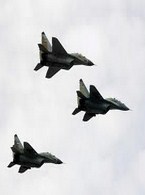offline
- nelsa

- Super građanin

- Pridružio: 21 Sep 2011
- Poruke: 1118
|
Napisano: 08 Okt 2012 12:06
Smatra se da su izuzetno pokretni i na vojnim vježbama su u vrlo kratkom roku prebacivali ogromnu količinu tehnike i ljudstva s jedne strane zemlje na drugu,to je sve naravno moguče zahvaljujuči ogromnoj helikopterskoj floti, floti transportni aviona,velikom broju kamiona/tegljača i nesječam se tačnog podatka o kojem broju se radi ali znam da imaju takodje ogroman broj transportni kamiona/tegljača spremni u svakom trnutku.
Iran drži po svim standardima ogroman broj artiljerije i podaci od prije desetak godina govore o više od 12.000 artiljerijski cjevi kalibra večim od 80 mm a danas je taj broj i veči a od toga je oko 4.000-5000 hiljada topova od kojih je oko 1000 samohodni a ostali trebaju šlepere,tu je još oko 5.000 minobacača a ostalo su VBR-ovi,ne vodjeni projektili...itd, od čega dobar dio VBR-ova i minobacača takodje treba šlepere pa je i potreba za transportnim kapacitetima ogromna,tako da u tom djelu što se tiče mobilnostii i brze reakcije u kriznim situacijama kotiraju visoko.
O organizaciji smo dosta govorili a što se tiče efikasnosti to niko nemože znati kako če u datim okolnostima neka vojska reagovati ali činjenica je da Iran dosta dobro stoji s logistikom,imaju jaku vojnu industriju koja tehniku održaje i modenizuje,ono što je bitno takodje je da godišnje veliki broj vojni vježbi i to vježbi velikog obima održe u svim rodovima,opčenito u vojnim krugovima oni su medju vodečim vojnim silama svjeta i analitičari Iran svrstavaju veoma visoko,mislim po zadnjoj procjeni 12-sta sila, ali to je več široko područije i inače ne ulazim u rasprave tipa je li neko prvi.peti...jer to ništa negovori i to smo vidjeli x-puta,takve stvari zavise od milion faktora i prije svega zavisi šta se procjenjuje,da li ofanzivni kapaciteti,defanzivni....,Iran ima čisto defanzivnu doktrinu i to se po organizaciji i vojnoj tehnici koju preferiraju odma vidi i oni konvencionalnu vojsku razvijaju isključivo za odbrambeni rat i zbog toga i inventar vojne tehnike izgleda tako,e sad zbog specifičnosti njihove situacije i pozicije u odnosu na USA oni su prinudjeni razvijati i neke ne konvencionalne tehnike ratovanja i u skladu stim naoružavaju mornaricu i raketne snage koje su isključivo dio IRGC i zbog svega ovoga Iran treba gledati kroz prizmu da če uvjek biti strana koja se brani i organizacija i vojna tehnika koja je potrebna za ovakav rat nije ni slična od one koja je potrebna u situaciji kada je u planu invazija neke zemlje,pa samim tim po organizaciji i vojnoj tehnici koju preferira zemlja možemo i vidjeti kako je opredjeljena i kako če se ponašati u sukobu.
IRGC dokumentarac o raketnim kapacitetima

U subotu je Izraelski f-16 srušio neidentifikovani UAV koji je leti u Izraelskom zrčnom prostoru oko 30 minuta
Downed drone: Iran testing Israel's capabilities

Unmanned aircraft shot down by F-16 jets in south Israel
10.06.2012
A few hours after two fighter jets shot down a small unmanned aircraft that penetrated Israeli airspace in the south Saturday morning, it is safe to say that an element operating in Lebanon under the auspices of Iran and with its support, apparently Hezbollah, activated the drone. The drone itself, which was downed in the south Mount Hebron area, was apparently made in Iran.
Operating a drone by remote control from such a long distance requires advanced capabilities, which Israel was not aware Hezbollah had acquired.
Hezbollah's drones have infiltrated Israeli airspace in the past, from the north, but their activation did not require any navigation system. The unmanned aerial vehicle (UAV) that infiltrated Israel on Saturday did require such a system. The incident showed that the Air Force has the ability to detect and intercept drones at any stage of their flight.
The drone was apparently launched by Iran or one of its allies to test the IDF's detection and interception capabilities, and perhaps even to search for specific targets in south Israel. The drone apparently began its flight in Lebanon and then headed in the direction of Gaza's coastline after flying over the Mediterranean Sea. This route was chosen not only because it utilized the depth of the sea's airspace, but also because Israeli UAVs regularly hover above Gaza.
The drone's operators may have planned to take advantage of this fact in hopes of confusing Israel's detection and interception systems. However, the drone was detected while it was still flying over the Mediterranean Sea and was downed a half-hour later over the south Mount Hebron area after IAF jets made certain it was not carrying any explosives and that its main mission was intelligence gathering.
There is no doubt that the operation is indicative of a high level of sophistication of the drone's operators, who are apparently Hezbollah terrorists, and also of their plans to perhaps use similar Iranian-made aircraft in the future to destroy targets inside Israel. It is also clear that Hezbollah chose such a long route so that it would not be accused of sending the drone and risk Israeli retaliation.
In other words, Hezbollah tried to conceal the fact that it had sent the drone by selecting a long route that passed through the Mediterranean Sea. It wanted the drone to enter Israel near Gaza, perhaps in an attempt to place the blame on Hamas, which is currently considered hostile to elements that are loyal to Iran.
Hezbollah has launched drones into Israel a number of times in the past. Before the Second Lebanon War two Iranian-made "Abibal" drones successfully infiltrated Israel, and during the war itself Hezbollah sent drones through the sea, perhaps in an attempt to blow them up in Israeli communities. These attempts failed, and in at least one incident a drone launched by Hezbollah was shot down by an F-16 over the sea.
Iran recently announced that it had developed small unmanned aircraft and cruise missiles with a range of hundreds and maybe even thousands of kilometers. The drone that was intercepted earlier in the day may have been one of the new models manufactured by Iran. Syria is also capable of operating drones from a long distance.
As far as Israel is concerned, Saturday's incident calls for increased alertness and preparations to thwart such infiltration attempts in the future. If it turns out that the drone was Iranian and was launched by Iran or Hezbollah, Israel would have to consider its response to such a blatant violation of its airspace. In light of the successful interception and the explosive situation in the Middle East, Israel may decide to act with restraint and not respond at all. It will certainly want to avoid a massive response that may ignite the entire region.
Israel will also examine the possibility that the drone was supposed to take photographs of areas in south Israel, including photos of the reactor in Dimona.
[Link mogu videti samo ulogovani korisnici]
DUBAI (Reuters) - The incursion by an unmanned aircraft into Israeli airspace at the weekend exposed the weakness of Israeli air defenses, an Iranian military official was quoted as saying on Monday.
The Israeli air force shot down a drone on Saturday after it crossed into southern Israel, the military said, but it remained unclear where the aircraft had come from.
Jamaluddin Aberoumand, deputy coordinator for Iran's Islamic Revolutionary Guard Corps, said the incident indicated that Israel's Iron Dome anti-missile defense system "does not work and lacks the necessary capacity", Fars news agency reported.
The Iron Dome system, jointly funded with the United States, is designed to shoot down short-range guerrilla rockets, not slow-flying aircraft. It intercepted more than 80 percent of the targets it engaged in March when nearly 300 rockets and mortars were fired at southern Israel, the Pentagon said at the time.
The drone was first spotted above the Mediterranean near the Hamas-ruled Gaza Strip to the west of Israel, said military spokeswoman Avital Leibovich. An Israeli warplane shot it down above a forest near the occupied West Bank.
Israeli parliament member Miri Regev, a former chief spokesman of the military, wrote on Twitter it was an "Iranian drone launched by Hezbollah", referring to the Lebanese Shi'ite group that fought a war with Israel in 2006.
Israeli defense officials have not confirmed this.
Aberoumand attributed claims the drone was made by Iran to a "psychological operation" by Israel, but did not confirm or deny them. "The Zionist regime (Israel) has many enemies," he added.
On at least one occasion, Iranian-backed Hezbollah has sent a drone into Israeli airspace. And in 2010, an Israeli warplane shot down an apparently unmanned balloon in the Negev near the country's Dimona nuclear reactor.
The Israeli military released a 10-second video clip of what it said was Saturday's mid-air interception, showing a small aircraft just before a missile from a fighter jet destroys it.
Israel has threatened to bomb Iran's nuclear sites if diplomatic efforts fail to stop the nuclear work it believes is aimed at getting weapons capability, a charge Tehran denies.
Iran has responded with threats to attack U.S. military bases in the region and retaliate against Israel if attacked.
(Reporting By Yeganeh Torbati; Editing by Alistair Lyon)
Ovdje je kompletan snimak koji je snimio Iranski UAV špijunirajuči Američki nosač.

UNCLASSIFIED
Annual Report on Military Power of Iran April2012
Preparation of this reportfstudy cost the
Department of Defense a total of
approximately $22,000 for the 2012 Fiscal Year
[Link mogu videti samo ulogovani korisnici]
|

